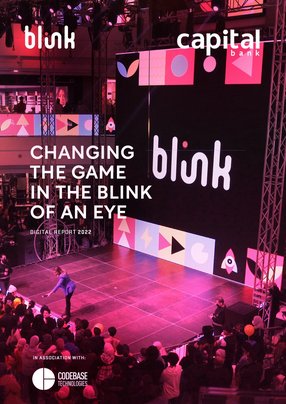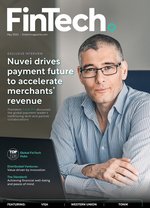Capital Bank of Jordan: Changing the Game in Blink of an Eye
Blink was launched in February 2022 under the umbrella of Capital Bank of Jordan (CBJ) ‒ a bank that has undergone a fair amount of transformation in recent years.
Established in 1995 as primarily a corporate bank, CBJ focused on trade finance and building key corporate relationships, leading to the creation of a strong corporate portfolio for the bank. As a by-product of its corporate business, CBJ had a retail business that targeted high-net-worth individuals and business owners, cementing its status as a fully-fledged commercial bank.
This experience lent itself well to the bank’s more recent transition away from high-net-worth individuals and corporates into mass retail banking, in addition to its core aim of supporting the growth of SMEs in Jordan.
According to Zein Malhas ‒ who joined in 2018, utilising her prodigious skill to work up to the role of Chief Digital Officer in January 2021 and CEO of Blink just a year later ‒ the bank has, over the years, expanded its remit geographically and into other areas of banking. “Capital Bank of Jordan is basically a group that also encompasses a commercial bank in Iraq ‒ the National Bank of Iraq ‒ of which we own 62% and that has a presence in Iraq and Saudi Arabia, as well as an investment bank, Capital Investments, with presence in Jordan, Iraq, and UAE.”
With transformation being the name of the game for Capital Bank of Jordan in recent years, the institution ventured into the establishment of Jordan’s first true digital bank, creating Blink as a means of separating it from traditional banking institutions and instead carving its own unique consumer space in the market to target Gen-Zs and Millennials with a completely new approach to banking.
The core brand ‒ setting Blink apart
Blink is meant to be a bank with a different approach. “Our pitch is that we are doing things differently. So our brand was built on the notion that money is holding us back. We feel that our target market’s perception of banks is that, instead of allowing them to live more, they actually hold them back. It's their money.”
“We make banking easier and fully digital ‒ all of our services are on our mobile app. Our unique selling point today is centred around unsecured lending. So our first product is instant credit cards.” As such, Blink is the first bank in Jordan to introduce credit cards without the need for salary transfer or providing any form of collateral. This comes as an opportunity to those that are unbanked due to not having a stable income, such as students and housewives, and, accordingly, aims to support financial inclusion in the country.
“We have a risk model that we’re running in the background ‒ it’s not pre-approved credit, by any means,” Malhas clarifies. “It is a fully-digital experience that allows the customer to obtain a credit card within three minutes and instantly use it in eCommerce, because it's a virtual credit card. Then we deliver the physical card to the customer for them to use, as well.”
Blink has a clear roadmap in place, with future objectives moulded to simplify banking for younger generations and those outside of financial circles.
“Currently, we're looking at saving accounts, current accounts ‒ basic forms of deposits,” Malhas says. “All of our banking products are going to be offered to customers, then tweaked to their needs and simplified.”
“One of the things we've been really focusing on doing is shying away from the usual banking jargon. An account is an account, you can put money in and manage it. You can open a sub account. Eventually, we will add more products that incentivise savings, as well as a loyalty solution.”
Even in its approach to loyalty, Blink is changing the game. “Typically, banks have a loyalty programme that is based on points and the burning of these points. So you earn, you utilise them, and then you either convert them into cash or you use them in a certain merchant network. In Blink we are focusing more on engagement. An unconditional form of love to our customers, we will not ask them to do something to earn points in return, we will surprise them with personalised rewards that show our gratitude and, with that, you earn loyalty,” she says.
Evolution of Blink
Zein Malhas’ role as CDO of Capital Bank has been key to its fintech credentials, kickstarting and fleshing out the development of a neobank: “The objectives of Blink are based on completely disrupting the banking industry. It was never meant to be just a tick-box exercise.”
Establishing Blink was not about converting Capital Bank’s customers to digital.
Malhas says: “Our strategy for Blink was never a conversion strategy, which means that it wasn’t our approach to Capital Bank’s overall digitisation per se, because the bank itself is still very much focusing on digital transformation and investing heavily in digitising all of its processes ‒ whether front-end, customer-facing or back-end ‒ in order to increase efficiency and reduce costs.”
“We do not have that critical mass that we intend to shift to digital. Rather, this is more of a customer acquisition strategy ‒ we wanted to tap into markets that have been traditionally under-served, with our focus being to serve the under-banked and the unbanked.”
Contrary to assumptions, ‘unbanked’ doesn’t necessarily refer to lower income, blue collar workers deemed as ‘not bankable’ by financial institutions. Rather, it encompasses the bankable population that are either not digitally native or who are simply intimidated by, or do not trust, banking services. These groups may be under-served in the sense that their current banking solution fails to meet their needs.
The idea for Blink was first conceived when Capital Bank’s Group CEO, Dawod Al Ghoul, called Malhas and stated his desire to launch a neobank ‒ although Malhas initially had reservations: “I was reluctant at first. Retail banking seemed to be a red ocean in that it’s very competitive, and Capital Bank had long embarked on a digital transformation journey that positioned it as a leading digital solutions provider. We were already onboarding customers via WhatsApp, we had invested in a new mobile banking app, and we were investing in digitization at all levels.”
However, the conversation highlighted the alternative audience that a neobank could tap into to meet the needs of those who are often overlooked. “Those who would like to bank with Capital Bank are not the same as those who would like to bank with Blink,” she says. But why is this the case? “You can add lifestyle elements, you can add a whole different experience and you can address customer needs in a completely different way. Simply put, you can break free from the boundaries of traditional banking, and with that target a whole new segment.”
Another key reason for the decision was how the sheer volume of time and learning required to transform CBJ’s digital solutions would enable it to ‘leapfrog’ into the neobank space: “When Dawod spoke about agility and time-to-market, I was convinced instantly, so immediately after that we started the project. We launched Blink ‒ from the idea to go-live ‒ within six months. We started from nothing and put it all together within a record time, including the strategy, the branding and the technology.
Pandemic-related shift to digital banking innovations
As was the case for most ‒ if not all ‒ businesses in 2020, the COVID-19 pandemic had a wide-ranging impact on Capital Bank. But while the sudden halting of businesses worldwide and ongoing supply chain issues caused many to falter and redirect their attention, Malhas explains how the pandemic merely sped up what is seen as banking’s natural progression.
“Nowadays, all products are focusing on digitisation, so banks are no longer thinking about introducing products without the digital element, because that's the expectation of customers,” she says. “Of course, the pandemic paved the road for all banks to actually ride the digital wave, which was gradually becoming less of a choice, anyway.”
During this period, Malhas came across an overwhelming abundance of solutions and potential partners for Capital Bank: “On a weekly basis, I would meet two or three potential partners that would come and showcase their solutions. Putting all of this within a framework, deciding how to go about it and making sure that, along the way, you don’t forget your customer, was a challenge. The best way to overcome this challenge was Blink.
“It all came together easily and in a short space of time. We are now in the best position to utilise the ecosystem of partners available to us, within a clear partnership framework that maximises value to our customers.”
Building partnerships to support digital banking transformation
A successful digital transformation roadmap factors in the potential partners that can help progress the journey so, naturally, Blink has cultivated a wide range of strategic partnerships in the tech field.
“We have many partners, but our main ones are, of course, Codebase Technologies, as we obtained our full technology stack from them,” says Malhas. “One of the things that I personally was extremely passionate about was to have an altogether separate technology stack because, from my experience, riding on your existing technology sometimes pulls you back.
“Of course, this is not the case for every single institution ‒ you have to measure what works for you to assess properly. But for us, we really felt that the way to leapfrog is to have that segregation and, accordingly, we obtained a ‘bank-in-a-box’ kind of solution from Codebase Technologies, which included the core banking system, channel, application, middleware, a rules engine, and other peripheral systems.”
The technology stack provided by Codebase Technologies was built on open banking with over 400 APIs exposed, making integration with third-party solutions seamless and supporting Blink’s plans to maximise partnerships.
“It is extremely agile and easily enabled us to integrate with third parties, which allowed us to launch the bank within a very short period of time.”
The future of banking ‒ going digital
Without a crystal ball helping determine the future, it’s difficult to assess exactly where the world of finance is heading ‒ one thing that is certain, though, is that the future is in digital banking. So how does this relate to Blink’s outlook over the next year or so?
“For Blink, we have a very big roadmap,” Malhas enthuses. “The next 12-to-18 months are going to hopefully include a lot of enhancement in terms of the current minimum viable product that we launched into the market, in addition to introducing daily banking services.”
“But we want to hear back from customers first ‒ so, while we have an aspirational roadmap, we will prioritise and tweak services after hearing back from customers to see what we should improve, what products are more important, etc. We don't want to push products in the market thinking that they are the best because we’re just thinking of the competition or we’re thinking as bankers; we want to hear it from our customers.”



